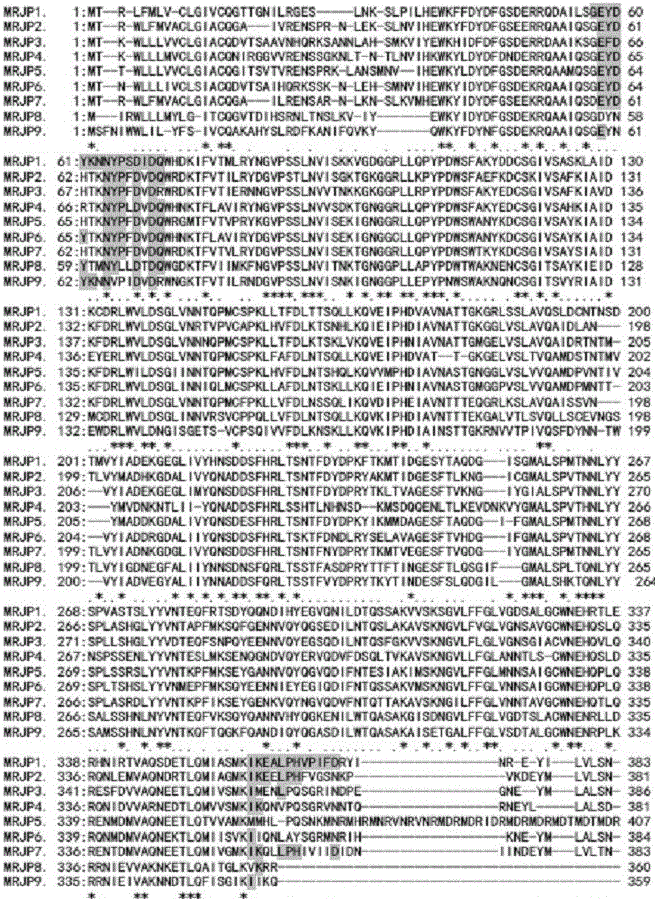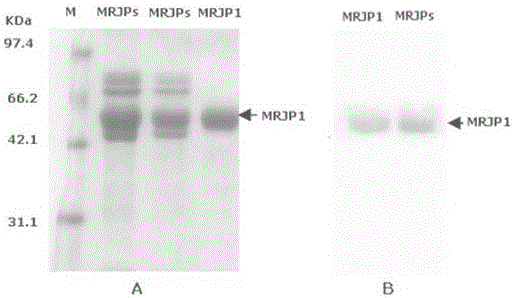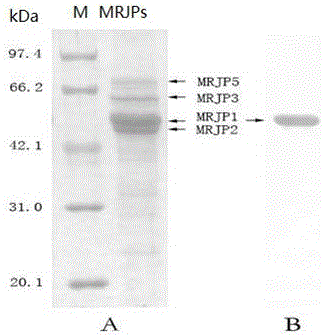Preparing method and detecting method for MRJR1 antibody pairs in honey and kit
An immunological detection method and antibody pair technology, which is applied in the field of determination of honey component content, can solve the problems that there is no fast and low-cost method for detecting the quality of honey, and it is impossible to distinguish true and false honey, and achieve high accuracy, high sensitivity, and catalytic efficiency. high effect
- Summary
- Abstract
- Description
- Claims
- Application Information
AI Technical Summary
Problems solved by technology
Method used
Image
Examples
Embodiment 1
[0031] Example 1: Screening of MRJP1-specific polypeptides
[0032] Log in to the international gene information database http: / / www.ncbi.nlm.nih.gov / , search and download the amino acid sequences encoded by the genes of the 9 members of the MRJPs family (MRJP1~MRJP9), the sequence number of MRJP1 is NM_001011579, and the sequence number of MRJP2 为NM_001011580、MRJP3的序列号为NM_001011601、MRJP4的序列号为NM_001011610、MRJP5的序列号为NM_001011599、MRJP6的序列号为NM_001011622、MRJP7的序列号为NM_001014429、MRJP8的序列号为NM_001011564、MRJP9的序列号为 NM_001024697. Input the amino acid sequence encoded by the above-mentioned sequence MRJP1~MRJP9 gene into GENTYX software for homology analysis, after the analysis is completed, the output is as follows figure 1 The homology analysis diagram shown ( figure 1 ).
[0033] according to figure 1 As a result of homology analysis, two specific polypeptides of MRJP1 were screened out: the polypeptide SGEYDYKNNYPSDID (SEQ ID NO: 2) located at positions 56-70 of the amino acid sequ...
Embodiment 2
[0034] Example 2: Preparation of MRJP1-specific polyclonal antibody
[0035] (1) Antigen preparation
[0036] Chemical synthesis was carried out according to the polypeptide sequences C-IKEALPHVPIFD-NH2 and C-SGEYDYKNNYPSDID-NH2. Conjugate 5 mg of synthetic polypeptide with KLH (the coupling agent is Sulfo-SMCC) as an immune antigen; mix another 5 mg of synthetic polypeptide with bovine serum albumin (BSA, a type of albumin in bovine serum, containing 583 amino acid residues base, molecular weight 66.430kDa) coupled (coupling agent glutaraldehyde) as the detection antigen. Dilute with PBS to a concentration of 1mg / mL, aliquot and store at -20°C.
[0037] (2) Immune rabbits
[0038] Two healthy New Zealand white rabbits were selected and immunized on days 1, 15, 29, and 43. The immunization procedure is as follows: Take 1 mL of antigen, add 1 mL of Freund’s complete adjuvant, emulsify, drop a drop of emulsified antigen solution into physiological saline, and use a syringe t...
Embodiment 3
[0041] Example 3: Purification of polyclonal antibodies by affinity chromatography
[0042] (1) Preparation of affinity chromatography column
[0043] 1 mL of thiol protein agarose-coupled resin (Sulfolink Resin) was coupled with 1 mg of synthetic MRJP1-specific polypeptide. 5 mg of synthetic MRJP1 polypeptide was linked to activated thiol protein agarose-coupled resin to prepare an antigen affinity column. The affinity column was equilibrated with 10 times the column volume of PBS, and the solution was drained.
[0044] (2) Antibody purification
[0045] Filter the polyclonal antibody serum with a 0.45 μm filter membrane, then pass it through an antigen affinity column, drain the solution, and collect the flow-through; equilibrate with 10 times the column volume of PBS buffer, drain the solution; add 5 mL of antibody eluent (Glycine 5g, dissolved in 100mL ultrapure water, adjusted to pH 2.7 with concentrated HCl, stored at 4°C), and the eluate was collected in 1mL / tube.
...
PUM
 Login to View More
Login to View More Abstract
Description
Claims
Application Information
 Login to View More
Login to View More - R&D
- Intellectual Property
- Life Sciences
- Materials
- Tech Scout
- Unparalleled Data Quality
- Higher Quality Content
- 60% Fewer Hallucinations
Browse by: Latest US Patents, China's latest patents, Technical Efficacy Thesaurus, Application Domain, Technology Topic, Popular Technical Reports.
© 2025 PatSnap. All rights reserved.Legal|Privacy policy|Modern Slavery Act Transparency Statement|Sitemap|About US| Contact US: help@patsnap.com



